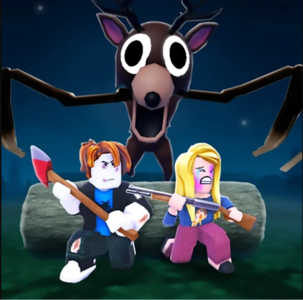99 Nights in the Forest: A Survival-Horror Masterpiece of Isolation, Fear, and Inner Collapse
Introduction: When the Forest Watches You Back
The forest has always been a place of myths and fears. From old folktales to modern media, it represents both life and the unknown. 99 Nights in the Forest isn't just a survival game—it’s a psychological experience that tests your wits, sanity, and emotional resilience. Set in a shifting, procedurally generated wilderness, this title drops players into a nightmarish cycle of survival, memory, and hallucination. With no hand-holding and only your instincts to rely on, the question becomes not can you survive, but should you?
Night 1–10: False Safety and the Learning Curve
In the beginning, the forest feels quiet. Peaceful, almost. Players start near a small abandoned campsite, where a few tools, food rations, and a broken radio offer the illusion of control. This is the onboarding phase—but it doesn’t feel like one. There are no pop-ups, no tutorials. You learn through failure. How to craft fire. Where to hide when the wind howls. How to eat without drawing attention.
Sanity is introduced as a mechanic here, represented by subtle environmental cues. The screen darkens slightly if you forget to sleep. Echoes play if your hunger stays too long. Even during these early nights, the forest hints that it’s watching you. You just don’t realize it yet.
Night 11–20: Patterns Break, Tension Builds
As players grow comfortable, the forest begins to shift. Animals start acting strangely—birds stop chirping, deer move in circles, shadows stretch farther than they should. Food becomes scarcer. The wind speaks in syllables that resemble your name.
The enemy isn’t clear yet. There are no zombies or monsters with health bars. Instead, it’s the presence of absence that disturbs. At night, the trees creak in patterns. During storms, whispers appear in the rain. You begin to realize the forest isn’t just alive—it’s learning your behavior. Leave your campfire in the same place too many nights in a row, and something may be waiting there next time.
Night 21–30: The Psychological Fracture Begins
What separates 99 Nights in the Forest from most horror-survival games is its commitment to realism intertwined with surrealism. By night 30, the character’s inner voice becomes more active—sometimes helpful, sometimes contradictory. When starving, you might hear a soft voice say, “The berries are safe,” even though you know they’re not.
The sleep mechanic evolves. Dreams become playable sections, filled with warped versions of real locations. These dreamscapes offer glimpses into the protagonist’s past. A broken home. A car crash. A child’s voice calling out in the dark. Whether these are literal memories or sanity-induced visions remains up to interpretation, but they deepen your emotional investment—and unease.
Night 31–40: The Forest Reveals a Face
This phase introduces “The Watcher,” a recurring entity that doesn’t chase you—it just exists. Sometimes it appears as a silhouette at the tree line. Other times it’s reflected in puddles or in your dreams. Its purpose is unclear, but its presence is undeniable.
Gameplay-wise, this section becomes more intense. You begin managing not just hunger and warmth, but trust in your own perception. You may hear a scream and rush to help, only to find nothing. Or worse, something waiting. The forest becomes a character—one that lies, tempts, and punishes.
Exploration opens up. The deeper regions introduce ruins, carvings in stone, and abandoned structures filled with journals written in your handwriting. It becomes apparent that time in the forest doesn’t move linearly.
Night 41–50: Paranoia and The Other Survivor
Around this stage, a new mechanic is introduced—a radio signal with a human voice. It identifies itself as “Avery,” claiming to be another person lost in the forest. They offer tips, warn you of dangers, and sometimes even guide you to supplies.
But the voice changes tone inconsistently. Some nights it’s helpful. Other nights, it whispers threats. Players are given the option to reply, and their tone influences future behavior. One wrong response, and Avery stops helping. Or perhaps they were never helping at all.
This creates an extraordinary dynamic: are you alone, or not? Is Avery real, or just your mind projecting a voice to break the silence?
Night 51–60: The Fracturing Reality
Here, 99 Nights fully commits to psychological horror. Your character begins to question reality, and so does the gameplay. Trees shift positions when you're not looking. The compass spins randomly. Your crafted weapons disappear overnight. In one haunting segment, your camp is replaced with a perfect replica—except it's missing all your belongings.
The mirror mechanic is introduced. Occasionally, the forest flips into a dark variant. Rivers run black, birds cry like infants, and the music becomes distorted. In these "mirror" nights, your past actions return as consequences. Did you kill a wolf that was stalking you? Its pack may now haunt your dreams. Did you ignore a dying animal? You might hear it sob under your bedroll.
The narrative unravels like a poem. Not direct. Not certain. But deeply emotional.
Night 61–70: The Buried Truth
With the forest fully open, players can now explore sacred groves, underground crypts, and towering burnt trees that pulse like veins. The theme of guilt becomes central. Every journal found references a different name—but always the same tragedy: a child lost in the woods.
The game forces you to confront the possibility that you may be the one who lost them. Or worse, abandoned them.
At this point, you’re not just surviving—you’re seeking redemption. Or maybe punishment. The line is blurred, and the game’s systems reflect that. The sanity meter becomes more erratic. Events occur that you can’t control. Days sometimes last minutes, other times feel like hours.
Night 71–80: Choice and the Unknown
The end draws near, and the game begins hinting at multiple outcomes. You can follow the signal from Avery and find their bunker. You can locate the ruined cathedral at the forest’s center. Or you can build the “Memory Tree,” a massive structure that requires every item you’ve saved and every moral decision you’ve made.
Each path offers a different philosophical closure. Not all are “good,” and none are definitive. But they all reflect who you’ve become over the course of 70+ hours of gameplay.
Mechanically, crafting becomes scarce. Enemies (or hallucinations) become bolder. You may lose the ability to distinguish real footsteps from echoes. Every item feels heavier, every decision final.
Night 81–98: The Long Dark
You’re exhausted. So is your character. The game slows down intentionally. Fewer scripted events. More silence. The weight of your choices becomes suffocating. You begin to reflect—not just on the game, but on yourself.
Some nights, nothing happens at all. You wait, expecting horror. But all you hear is wind. And somehow, that’s worse.
The forest is dying, or you are. Trees collapse. Rivers dry. Animals vanish. The final week is about acceptance. Or refusal. You’re given tools to finish your story, but no guidance on how to use them.
And then comes the 99th night.
Night 99: The End and What It Means
The final night is simple. You wake up with no HUD. No voiceover. No music. Just footsteps toward a light in the distance. The path forks three times. Each leads to a different ending:
-
The Exit: a highway tunnel with lights, cars, and civilization
-
The Root: a downward staircase into blackness, with the Watcher waiting
-
The Campfire: your original spot, now empty but familiar
Each ending is a reflection. Not of success or failure, but of who you are. One ending may reveal that the child was never real. Another may confirm it all happened. A third may say nothing at all.
And then the screen fades to white.
Conclusion: The Forest Remains
99 Nights in the Forest is not a traditional game. It's not here to be beaten or conquered. It’s an interactive descent into isolation, grief, and memory. Every mechanic serves the narrative. Every night is a reflection of the player’s choices—whether active or passive.
99 Nights in the Forest rare to find a game so deeply committed to its theme. Rarer still is one that trusts the player to interpret it. This is more than horror. It’s more than survival. It’s an experience—and one you won't forget.
































